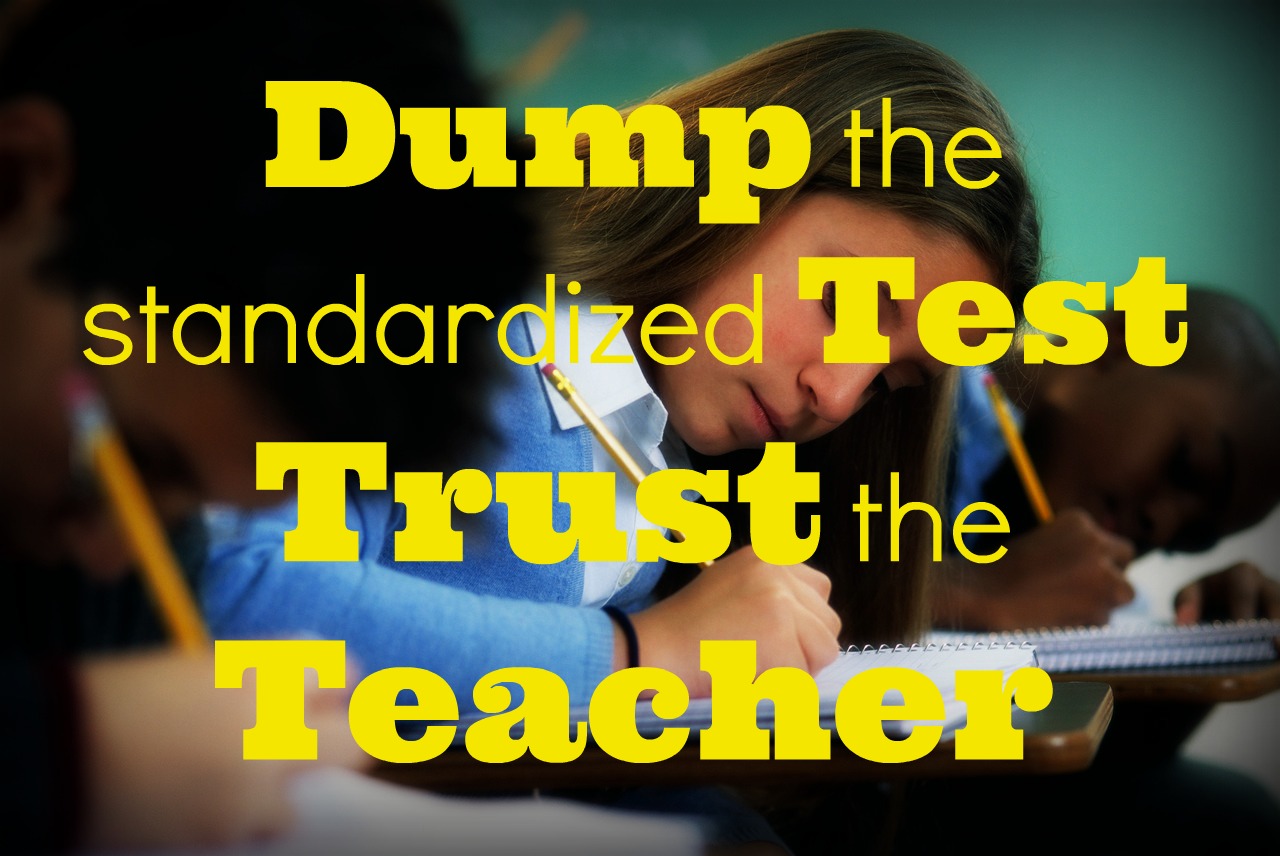A few years ago we lived in small town Texas. It was a one-stopsign kind of town. My children could safely walk or ride bikes to the library and when it rained, people would stop and offer them their umbrellas. There wasn’t a lot of money in the town. One day near the end of the school year I passed the elementary school and saw a sign, “Good test scores are good for business!” No pressure kids! Over half of the community is employed by the local school district, so test scores do matter.
 Why do I care? I homeschool. My own children don’t have to take a standardized test. My oldest daughter took her first multiple choice test to get into junior college, and that didn’t stop her. I don’t grade. If they don’t do an assignment well enough, we redo it. If they miss a couple math problems because they misread a number, or some such…I let it pass, unless that happens too often. If there is a pattern of missed math problems of a certain type, we redo it. I don’t have to press on to the next subject to keep up with a schedule. I’m not teaching a subject at all, I have the luxury of teaching a child.
Why do I care? I homeschool. My own children don’t have to take a standardized test. My oldest daughter took her first multiple choice test to get into junior college, and that didn’t stop her. I don’t grade. If they don’t do an assignment well enough, we redo it. If they miss a couple math problems because they misread a number, or some such…I let it pass, unless that happens too often. If there is a pattern of missed math problems of a certain type, we redo it. I don’t have to press on to the next subject to keep up with a schedule. I’m not teaching a subject at all, I have the luxury of teaching a child.
With testing…I have some long drives with my older children. For my son, it’s choir. We have a weekly 30 minute drive. That’s a great amount of time to talk with him about what he’s learning, how he feels it’s going, and what’s frustrating him. That conversation is far more effective than any test.
I only have 10 children.
I need public schools to work. Most of the doctors, policemen, nurses, politicians, and voters are public schooled. Homeschool isn’t and shouldn’t be for everyone. We have to have effective, functioning public schools. So how do we gauge this? How do we know if that school over there is doing well?
Teachers cannot take a child and just dump the learning in. Measuring the learning a child has received is not like reading a test tube. As Plutarch says, “The mind is not a vessel to be filled by a fire to be kindled.” How do you measure fire? How do you measure how close a child is to catching interest in a subject? Is the teacher less a teacher if the child figures out a tough math algorithm three days after testing? How does the idea of lighting a fire fit in with standardized testing and 6 week grading periods?
 We recognize good teaching one on one. We recognize learning one on one. How do we do this en masse? How do we help children in schools our children don’t attend? How do multiple choice tests measure music? How could we measure what we learn gardening alongside a teacher? How do we measure that the only voice I read Ma’s voice from Little House is my 3rd grade teacher Mrs. Crie? Teaching is an art. We can never identify the success of an art form with a multiple choice test.
We recognize good teaching one on one. We recognize learning one on one. How do we do this en masse? How do we help children in schools our children don’t attend? How do multiple choice tests measure music? How could we measure what we learn gardening alongside a teacher? How do we measure that the only voice I read Ma’s voice from Little House is my 3rd grade teacher Mrs. Crie? Teaching is an art. We can never identify the success of an art form with a multiple choice test.
Even if testing could verify teaching success, testing a child under age 10 with a long multiple choice test is rarely solely about learning. It’s much more likely that it’s testing whether they sat by the window in the carpool, if they lost their favorite toy, and if their pet is currently lost or found. What about children in unstable environments? Is a child with a very sick parent, a parent in prison, a child whose parents are considering divorce..is that child supposed to manage to pull it together to get the scores needed to ensure their school gets the money it needs to be a stabilizing force in their lives? The kid whose parents can’t help with homework because they are busy working, don’t speak the language, or are stressed and busy trying to feed their child…that kid tends to not test as well. Her school gets less funding.
That school is most likely to need creativity, thinking outside the box, and a unique approach. Instead they are most likely to be run in a poverty mentality…fear. Fear of failure, fear of low test scores, and fear of violence. This fear is evidenced by an increase of oversight and rules and testing. There is increased control. It’s a fixed mindset. How can we learn in a culture of fear?
 Take a look at grading policies. Is grading communication between the teacher and student, or is it a reward? Is grading the beginning of learning or does it signify the end of learning? How can we, as parents, help a child learn from their grades? We say mistakes and failure are a normal part of learning…then punish low grades. Should we? Were the poor grades evidence of bumps along the road to learning, or laziness? If a child is getting B’s on every single item and test, then misses one test, math tells us they get a lower grade, even when logic tells us this student really knows a good amount of this subject.
Take a look at grading policies. Is grading communication between the teacher and student, or is it a reward? Is grading the beginning of learning or does it signify the end of learning? How can we, as parents, help a child learn from their grades? We say mistakes and failure are a normal part of learning…then punish low grades. Should we? Were the poor grades evidence of bumps along the road to learning, or laziness? If a child is getting B’s on every single item and test, then misses one test, math tells us they get a lower grade, even when logic tells us this student really knows a good amount of this subject.
In my experience, most teachers would be much better off with less testing, fewer interruptions, and less standardization. We aren’t paying teachers much. We are restricting their work and limiting their creativity.
I doubt there is a single person reading this who disagrees with much of this post. So what do we do from here?
We can value the unmeasurable aspects of education: play, casual discussions, dirt, kindness, and creativity. We can support learning and a love of learning that goes on far outside of the grading and testing process. That all works in our own homes. How do we help others?
At the very least, thank a teacher! Write letters to your own favorite teachers. They still remember you! In addition to whatever gift you give your children’s teachers…consider a few carefully thought out, detailed comments about what they have meant to your child.
Support a principal. Principals have a large part in developing the culture in a school. Is the principal creative? Does she trust the innate love of learning in a child? Does she trust her teachers?
Get involved. We can delay or eliminate standardized testing. We can support teachers and principals. We can encourage learning and creativity in our communities. Children are such natural learners with such insatiable curiosity. There is so much to learn in the world and so much to do, so many great books to read and write. Multiple choice testing will not get us there.
About Britt Kelly
Britt grew up in a family of six brothers and one sister and gained a bonus sister later. She camped in the High Sierras, canoed down the Colorado, and played volleyball at Brigham Young University. She then served a mission to South Africa.
With all of her time in the gym and the mountains and South Africa, she was totally prepared to become the mother of 2 sons and soon to be 9 daughters. By totally prepared she means willing to love them and muddle through everything else in a partially sleepless state. She is mostly successful at figuring out how to keep the baby clothed, or at least diapered, though her current toddler is challenging this skill.
She feels children naturally love to learn and didn’t want to disrupt childhood curiosity with worksheets and school bells. She loves to play in the dirt, read books, go on adventures, watch her children discover new things, and mentor her children. Her oldest child is currently at a community college and her oldest son is going to high school at a public school. She loves to follow her children in their unique paths and interests.
She loves to write because, unlike the laundry and the dishes, writing stays done. Whenever someone asks her how she does it all she wonders what in the world they think she’s doing.
Twitter •




I fully support your views on this subject. My children were in school the year the high stake tests began and overnight, schools changed. The teachers were stressed, the creative lesson plans ended, and the ability to meet a child’s needs was not possible. It was a frightening transition to watch. The teachers know where their students are.
We always avoided testing states while homeschooling. Portfolio assessments, which many states allow homeschoolers, make so much more sense. I was comfortable doing those if I had to be evaluated. They showed what a child was really capable of and where his passions were. They allowed for creative teaching–in fact, they encourage it.
When you judge a teacher on the ability or focus of the students, few teachers (or schools) will pass. There may be many reasons why a child has a bad score, and most of them are not the teacher’s fault.
Standardized testing is metrics based, not child based. It is similar to a CSR whose pay is based on how many calls he takes–he can’t take the extra time to really solve the customer’s problems. Add in a metrics system where he is judged on how long his calls take (to the second) and you have the situation our schools have to deal with.
Our teachers and schools are judged by the success of their students, resulting in less individual focus and less funding to those who need the funding. When a school in a low income area can be closed for “poor test scores” and that money funneled to a higher income area where the children do not have as many external pressures, something is very wrong.
Lauren…the CSR example you give really highlights the quantity vs quality problem in education! A slew of facts does not mean you understand history enough to not repeat it!… the wisdom and context and connections in history can never be revealed in a multiple choice, standardized test!
ON the focus side of things…my husband, a social studies teacher, talks about the “engaged” student concept. How can you tell if their brains are engaged? We can’t (short of wiring them…coming soon to a school near you 😉 ). They can be doodling, wiggling, staring at the floor, kicking their feet and still THINKING!